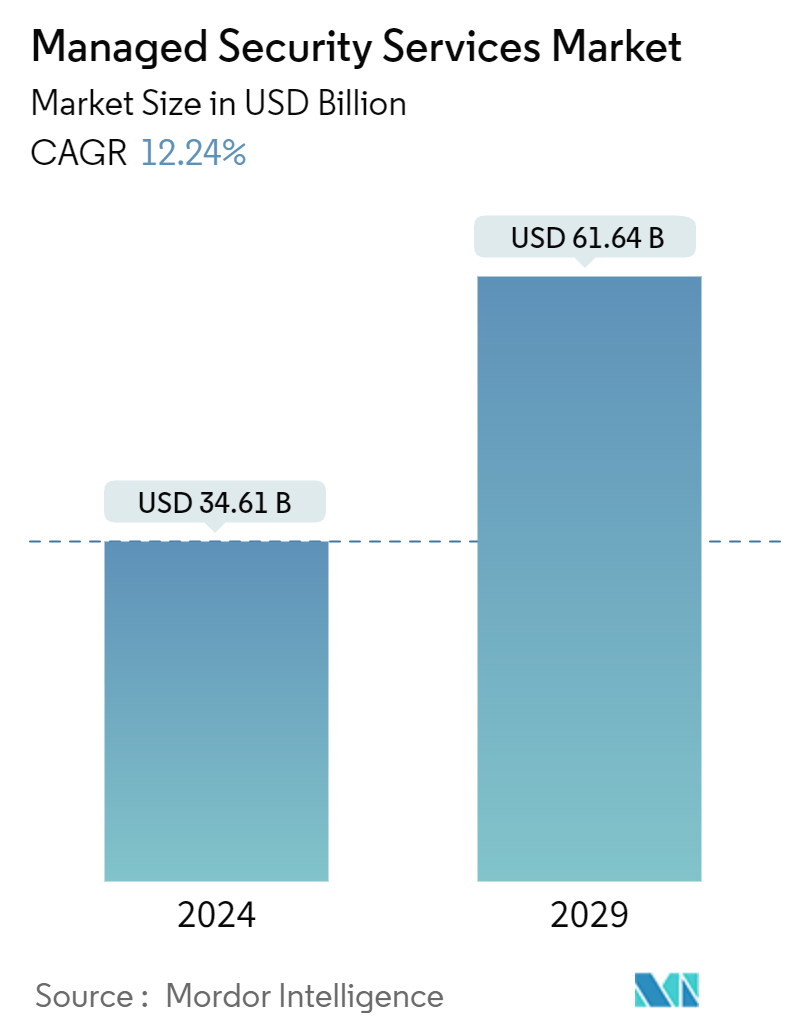Market Size of Managed Security Services Industry

| Study Period | 2019 - 2029 |
| Market Size (2024) | USD 34.61 Billion |
| Market Size (2029) | USD 61.64 Billion |
| CAGR (2024 - 2029) | 12.24 % |
| Fastest Growing Market | Asia Pacific |
| Largest Market | North America |
Major Players
*Disclaimer: Major Players sorted in no particular order |
Managed Security Services Market Analysis
The Managed Security Services Market size is estimated at USD 34.61 billion in 2024, and is expected to reach USD 61.64 billion by 2029, growing at a CAGR of 12.24% during the forecast period (2024-2029).
The market's growth can be attributed to the rising adoption of cloud storage, the emergence of big data analytics, and the increasing complexity of IT infrastructures due to IoT adoption. However, these advancements also heighten the risk of cyber threats, given the expanded attack surface.
- Managed security services involve outsourcing network security to specialized providers. Organizations often opt for managed security service providers (MSSPs) due to the complexity of maintaining a robust security infrastructure and the need for expert monitoring. This need is further underscored by the rising costs of data breaches, as evident from the accompanying graph. While traditional security solutions have evolved, they still struggle to detect newer, non-file-based threats, fueling the demand for managed security services.
- The global digitalization trend has provided cybercriminals with opportunities to exploit weaknesses in online systems, networks, and infrastructure. This has had significant economic and social repercussions on governments, businesses, and individuals worldwide. While phishing, ransomware, and data breaches are already prevalent cyber threats, new types of cybercrimes continue to emerge.
- The digital transformation era has fueled the expansion of data-intensive applications and technologies, resulting in a significant surge in the volume, velocity, and variety of data generated and processed by businesses. As organizations harness the potential of Big Data, artificial intelligence, and machine learning, securing this valuable asset becomes paramount. With the growing reliance on data-intensive approaches, organizations must manage large datasets containing sensitive information, underscoring the need for robust cybersecurity measures.
- The rising complexity of cyber threats is driving organizations to increasingly outsource their security operations. Choosing between an internal or outsourced Security Operations Center (SOC) carries significant consequences, as a single instance of malicious code infiltrating a business system can now spell the demise of the entire organization.
- The COVID-19 pandemic has not only disrupted businesses globally but has also expedited the rise of cybercriminal activities, both in private enterprises and government sectors, due to the push for digital transformation. This surge in cyberattacks during the pandemic has opened up avenues for endpoint detection and response solutions, given their effectiveness in mitigating cyber risks. As a result, the market for these solutions witnessed growth both during and after the pandemic.
- Additionally, the heightened internet traffic has significantly amplified the risk of cyberattacks across various businesses, necessitating the adoption of managed security services. The market for managed security services has further been propelled by advancements like firewall management and endpoint security, coupled with the surge in cyberattacks since the onset of the pandemic.
Managed Security Services Industry Segmentation
The managed security service market is defined by the revenues generated from diverse solutions used across various industries worldwide. The analysis draws from both primary and secondary research, capturing market insights. It delves into the key drivers and restraints shaping the market's growth.
The managed security services market is segmented by deployment type (on-premise and cloud), by solution type (intrusion detection and prevention, threat prevention, distributed denial of services, firewall management, end-point security, and risk assessment), by managed security service provider (IT service providers, managed security specialist, and telecom service provider), by end-user industry (BFSI, government and defense, retail, manufacturing, healthcare and life sciences, IT and telecom, and other end-user verticals), and by geography (North America, Europe, Asia Pacific, Latin America, and Middle East and Africa). The report offers market forecasts and size in value (USD) for all the above segments.
| By Deployment Type | |
| On-premise | |
| Cloud |
| By Solution Type | |
| Intrusion Detection and Prevention | |
| Threat Prevention | |
| Distributed Denial of Services | |
| Firewall Management | |
| End-point Security | |
| Risk Assessment |
| By Managed Security Service Provider | |
| IT Service Providers | |
| Managed Security Specialist | |
| Telecom Service Provider |
| By End-user Industry | |
| BFSI | |
| Government and Defense | |
| Retail | |
| Manufacturing | |
| Healthcare and Life Sciences | |
| IT and Telecom | |
| Other End-user Verticals |
| By Geography*** | |
| North America | |
| Europe | |
| Asia | |
| Australia and New Zealand | |
| Latin America | |
| Middle East and Africa |
Managed Security Services Market Size Summary
The managed security services market is poised for significant growth, driven by the increasing complexity of IT infrastructures and the rising adoption of cloud storage and big data analytics. As organizations expand their digital footprints, the risk of cyber threats escalates, necessitating the outsourcing of network security to specialized providers. This trend is further fueled by the limitations of traditional security solutions in detecting advanced cyber threats. The COVID-19 pandemic has accelerated the demand for managed security services, as the surge in cyberattacks highlighted the need for robust cybersecurity measures. The market is characterized by a diverse range of services, including endpoint detection and response, cloud security, and multi-factor authentication, which are essential for safeguarding sensitive data and maintaining the integrity of digital operations.
In the BFSI sector, the demand for managed security services is particularly pronounced due to the sector's focus on protecting client data and mitigating the risks associated with cyberattacks. The increasing frequency of distributed denial of service (DDoS) attacks and the evolving landscape of malware underscore the critical need for advanced security solutions. The North American region, with its rapid integration of IoT and the growing penetration of smart devices, is witnessing a surge in the adoption of managed security services. This growth is supported by the region's shift towards multi-cloud environments and the need for comprehensive DDoS protection. The market is highly fragmented, with major players like AT&T Inc., SecureWorks Corp., and Trustwave Holdings Inc. leading the charge through strategic partnerships and acquisitions to enhance their service offerings and maintain a competitive edge.
Managed Security Services Market Size - Table of Contents
-
1. MARKET INSIGHTS
-
1.1 Market Overview
-
1.2 Industry Attractiveness - Porter's Five Forces Analysis
-
1.2.1 Bargaining Power of Suppliers
-
1.2.2 Bargaining Power of Buyers
-
1.2.3 Threat of New Entrants
-
1.2.4 Intensity of Competitive Rivalry
-
1.2.5 Threat of Substitutes
-
-
-
2. MARKET SEGMENTATION
-
2.1 By Deployment Type
-
2.1.1 On-premise
-
2.1.2 Cloud
-
-
2.2 By Solution Type
-
2.2.1 Intrusion Detection and Prevention
-
2.2.2 Threat Prevention
-
2.2.3 Distributed Denial of Services
-
2.2.4 Firewall Management
-
2.2.5 End-point Security
-
2.2.6 Risk Assessment
-
-
2.3 By Managed Security Service Provider
-
2.3.1 IT Service Providers
-
2.3.2 Managed Security Specialist
-
2.3.3 Telecom Service Provider
-
-
2.4 By End-user Industry
-
2.4.1 BFSI
-
2.4.2 Government and Defense
-
2.4.3 Retail
-
2.4.4 Manufacturing
-
2.4.5 Healthcare and Life Sciences
-
2.4.6 IT and Telecom
-
2.4.7 Other End-user Verticals
-
-
2.5 By Geography***
-
2.5.1 North America
-
2.5.2 Europe
-
2.5.3 Asia
-
2.5.4 Australia and New Zealand
-
2.5.5 Latin America
-
2.5.6 Middle East and Africa
-
-
Managed Security Services Market Size FAQs
How big is the Managed Security Services Market?
The Managed Security Services Market size is expected to reach USD 34.61 billion in 2024 and grow at a CAGR of 12.24% to reach USD 61.64 billion by 2029.
What is the current Managed Security Services Market size?
In 2024, the Managed Security Services Market size is expected to reach USD 34.61 billion.

